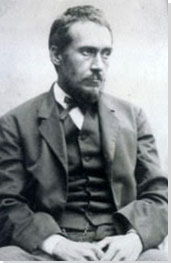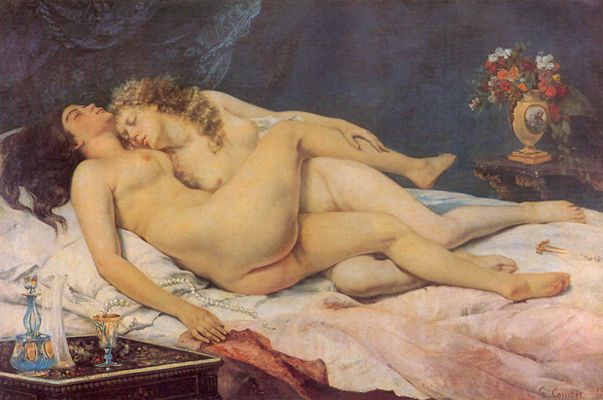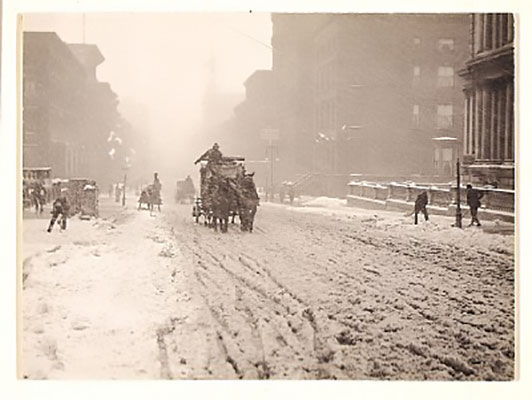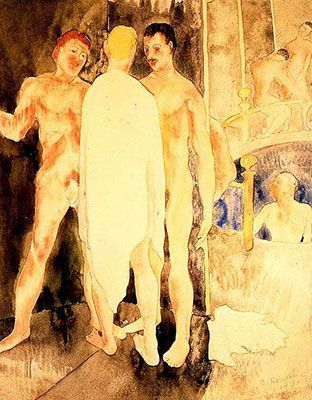Summary of Thomas Eakins
Working primarily in the second half of the 19th century, Thomas Eakins painted portraits and sporting scenes with resolute Realism. His style renounced idealized and romantic depictions and advocated instead for precise investigation of the human form and the natural world. He embraced photography from its beginning as a tool to prepare his compositions and his bold and resolute paintings would greatly influence the next generation of American Realists known as the Ashcan School.
Accomplishments
- Eakins was committed to scientific inquiry of natural laws to the point that he took anatomy lessons and observed dissections and surgeries. His uncompromising realism based on his astute observations brought a scientific rigor to his painting practice.
- Because he felt that professional artists needed to have complete knowledge of the human body and its workings, Eakins insisted on working from nude models. Controversially eschewing Victorian propriety, both his male and female students learned to draw observing the nude figure.
- Eakins' depictions of men and women were markedly different. His men, usually middle-class and professional, were portrayed at work or pursuing leisure activities, such as rowing and swimming. They embodied a virile masculinity with calm and repose. His women, however, were always shown in interior settings, and he emphasized their inner world, showing them in contemplation.
Important Art by Thomas Eakins
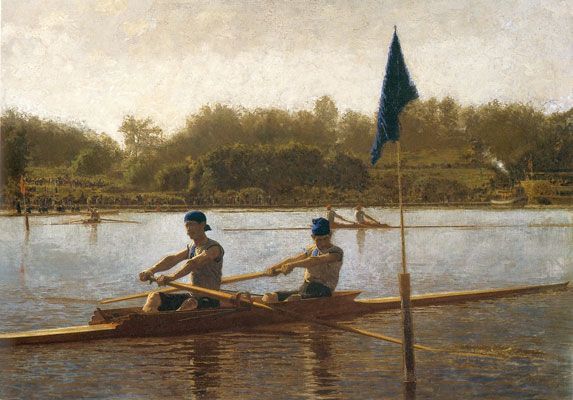
The Biglin Brothers Turning the Stake-Boat
Thomas Eakins' painting The Biglin Brothers Turning the Stake-Boat features a boat race on Pennsylvania's Schuylkill River. The focus is on the two-man crew in the foreground, wearing bright blue caps and pulling their oars through the water. They are in the process of passing a blue flag marker positioned in front and slightly right of the center foreground of the painting. In the background, other rowers can be seen and further in the distance black brushstrokes resemble a gathered crowd watching the race on the grassy, tree-filled field behind the river.
An athlete himself, rowing was one of Eakins' favorite leisure activities, and he created six large-scale paintings and a series of watercolors of the subject. Many of his rowing works featured the two brothers. Their good looks and personality made them popular figures in Philadelphia when they arrived from New York in 1872 to participate in races. Eakins began a friendship with the men and used them as models in many of his paintings for the next two years.
An important early work by Eakins, it bears the distinction of being the largest of his rowing-themed paintings. It also provides examples of the fine skill, attention to detail, and Realism that would dictate most of his oeuvre. Eakins depicts the figures at the height of motion. There is great emphasis on the muscles of the rowers' arms that are strained in the effort to push the oars through the water. This is a foreshadowing of the artist's growing obsession with the human form and of the many future nude studies and paintings that he would create.
Oil on canvas - Collection of The Cleveland Museum of Art, Cleveland, Ohio
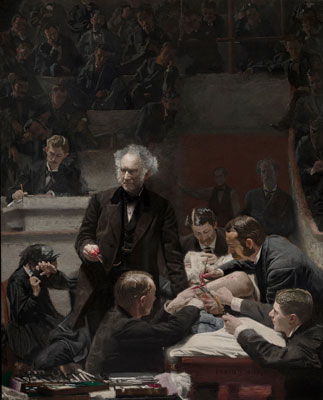
The Gross Clinic
An intense scene, Eakins' The Gross Clinic is large in scale, measuring eight feet wide and over six feet across. Eakins paints Dr. Samuel D. Gross, a teacher and surgeon at the Jefferson Medical College in Philadelphia, engaged in a teaching demonstration of a surgical procedure for the medical students seated behind him. Graphic in nature, five other doctors operate on a patient's infected thigh. This scientific endeavor contrasts sharply with the emotional reaction of the lone woman in the scene, presumably the patient's mother. Behind the operation on the right side of the painting, two figures watch the proceedings from the shadow of the room's doorway.
This work is one of Eakins' most important, well-known, and controversial paintings. It provides a clear example of his interest in scientific study and medicine. Perhaps as a nod to his own interest in the anatomy and dissection courses he took at the very college depicted in this work, Eakins decided to paint himself into the portrait and appears as one of the student observers. Eakins paid great attention to the technical details of the surgery, and the scene also shows great artistic skill and design in the way that he illuminates the otherwise dark scene with a wash of light coming down on the pale skin of the patient and the white sheets on which he rests. Dramatic effect and keen use of color is also demonstrated in the clear bursts of red used to show the blood on the victim's body and the assistants as well as the scalpel held by Dr. Gross.
Intended to be included in the Philadelphia Centennial Exhibition of 1876, Eakins wanted to create a complex portrait scene, but his Realism was all too real for the selection committee. The painting was shown, but in the U.S. Army Post Hospital exhibition, not the main exhibition space - certainly a snub to the artist. Reactions were mixed with some praising Eakins for his study of anatomy, but most questioning the purpose of the painting and its morbidity.
Oil on canvas - Collections of Philadelphia Museum of Art and Pennsylvania Academy of the Fine Arts, Philadelphia, Pennsylvania
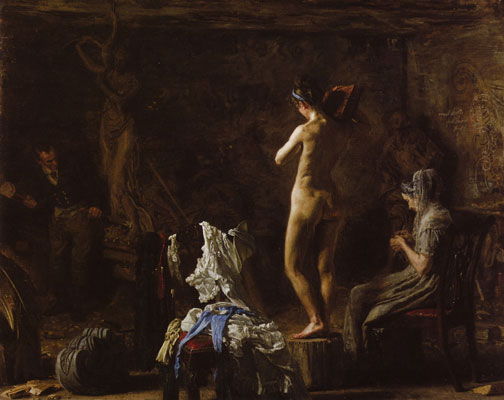
William Rush Carving His Allegorical Figure of the Schuylkill River
Thomas Eakins' William Rush Carving His Allegorical Figure of the Schuylkill River depicts Philadelphian sculptor and ship carver, William Rush, known for his allegorical works. In his studio, Rush stands in the background, carving a female figure based upon the nude woman posing in the foreground. To the right of the model a woman sits focused on her knitting, serving as the chaperone to the studio event. Daringly, the focal point of the work is not so much the artist or his model but a chair on which the model's clothes are draped. The bright white of her undergarments provide a burst of light in the otherwise darkly rendered scene.
An important work, this painting is the first of a limited number of historical paintings that Eakins made during his career. Despite the historical basis, however, the scene was one of the artist's imagination. The real model for Rush's sculpture most likely never posed nude. Additionally, some of Rush's other works visible in the studio were made after he completed this sculpture, thereby serving to show the artistic license Eakins took to make a more interesting, and arguably more controversial, scene.
The nude female in the foreground generated much controversy at the time. For some the insult lay in the model's unattractiveness, but others were shocked by the brazen way that Eakins presented her. As one New York Times writer remarked, "What ruins the picture is much less the want of beauty in the model, ... than the presence in the foreground of the clothes of that young woman, cast carelessly over a chair. This gives the shock which makes one think about the nudity - and at once the picture becomes improper!"
This painting serves as an early example of the obsession Eakins would have with the nude figure throughout his career. Often photographing himself and students in the nude, demanding that females have equal opportunity to work from male nudes in his classes, and painting numerous works in which a nude figure is prominently featured, nudity is a common thread that runs through his entire body of work. Eakins insisted that working from the nude form is the only way to truly understand and accurately depict the human body, but rumors persisted that his interest was more deviant.
Oil on canvas - Collection of Philadelphia Museum of Art, Philadelphia, Pennsylvania
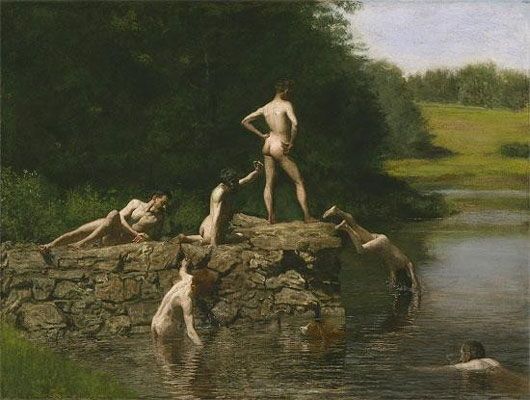
Swimming
Thomas Eakins' painting Swimming depicts six nude men swimming in a lake that is set in a lush green country setting. In the left foreground, a large rock juts out into the water. Two men are positioned on the rock in lounging positions while one stands with his back to the viewer and his hands on hips, presumably contemplating a jump and watching the man in front of him dive head first into the lake. One man stands in the water in front of the rock, looking down into the water, and a sixth figure along with a dog (the artist's red coated setter) swim towards the rock from the right bottom corner of the canvas.
Eakins took numerous photographs of these young men swimming, and he presents them on the canvas as they appeared in real life without any romanticizing effects. The unsentimental and frank depiction of the male nude in various poses has sparked much debate. The voyeuristic element of the paintings compounded when one learns that Eakins painted himself into the scene as the figure swimming toward the rock. Whether an innocent depiction of male camaraderie and frivolity, an acknowledgement of latent homosexual desire, a celebration of the nude form focusing on muscle, bone, and anatomy, or a deliberate attempt to court controversy and propel one's reputation, the painting is still a subject of debate more than a century after the artist's death.
Oil on canvas - Collection of Amon Carter Museum, Fort Worth, Texas
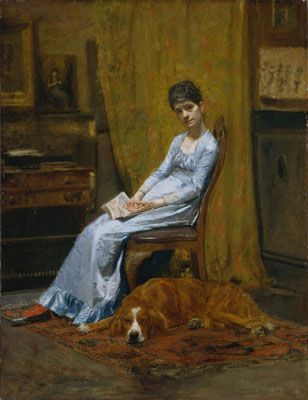
The Artist's Wife and His Setter Dog
In this painting Eakins' wife Susan wears a light blue dress and sits in a chair, a book resting unattended in her lap. She stares out at the viewer as her head tips to her right. At her feet, a large red dog lies on a similarly colored rug. Behind her are loosely rendered elements of a room, including a writer's desk, paintings on the walls, and a gold colored drape.
Eakins was known to be hard on his sitters and took a long time to complete a portrait. This fact coupled with his refusal to paint anything but a realistic portrayal of his subjects made many women reluctant to sit for the artist. As a result, many of the portraits he created of women were family and friends. Begun in the year of their marriage, 1884, Eakins depicts his bride sitting in what he described as "my own little home...where I have been very happy."
Unlike his male subjects, who Eakins depicted either working or pursuing leisure activities, Eakins depicted his female sitters in interior settings and emphasized a contemplative mood. Also unlike European portraitists of the past or his American contemporaries such as Merritt Chase, Childe Hassam, and John Singer Sargent, Eakins refused to depict a beautiful, idealized woman, opting instead for the more realistic rendering. As art historian Marc Simpson points out, "[T]he stark, merciless light that shines down from the skylight reduces any chance of idealization, catching the lines and creases of Susan Eakins's face and neck and highlighting the strength of her large, pianist's hands."
Oil on canvas - Collection of The Metropolitan Museum of Art, New York, New York
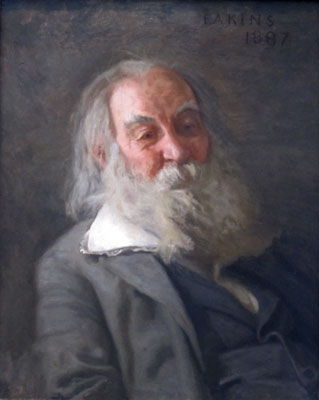
Portrait of Walt Whitman
This painting features a bust-length portrait of the famed American poet. The work is a study in gray tones, including the softly rendered brushstrokes of the background, the gray suit and vest and white shirt that the seated poet wears, as well as the bard's gray long hair and beard. Facing the right side of the canvas, the sitter looks slightly downward and off in the distance somewhere beyond the confines of the canvas.
When he wasn't working on commissioned portraits, Eakins often chose to create paintings of family and friends, including Whitman. The artist was introduced to Whitman by a mutual friend in the spring of 1887, and the two remained good friends. Upon Whitman's death, Eakins supervised the making of his death mask and served as an honorary pallbearer at the funeral.
Whitman was eager to have the artist paint his portrait and enjoyed the settings that many found too arduous. He described Eakins as being "possessed of marked peculiarities." Created in early 1888, the painting was important in that it was one of the first portraits the artist made after suffering through a depression resulting from his forced resignation from the Pennsylvania Academy. The realistic rendering of Whitman as he truly was with wrinkles and slightly unruly hair was characteristic of Eakins' unapologetically truthful approach to his portrait subjects. Well received, the painting was described by one critic as "by odds and far the best portrait yet made of an heroic figure in our letters." Perhaps more importantly, the sitter loved the portrait, and keeping it until his death, stated of the work, "Of all portraits of me made by artists I like Eakins' best: it is not perfect but it comes nearest being me."
Oil on canvas - Collection of Pennsylvania Academy of the Fine Arts, Philadelphia, Pennsylvania
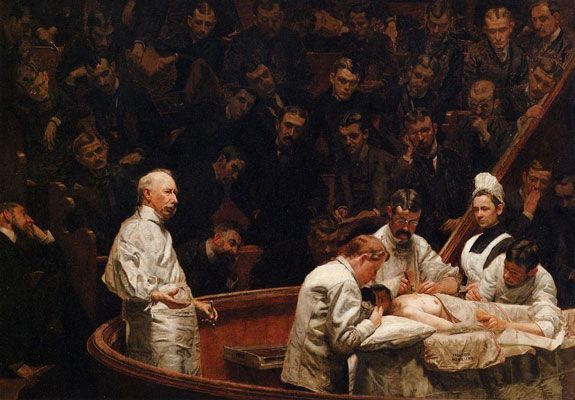
The Agnew Clinic
In this work, Eakins depicts Dr. Agnew, standing at the edge of the operating arena, overseeing a procedure in which three doctors perform a mastectomy on a female patient. Behind them, a female nurse stands at attention, presumably waiting to assist in the operation. Rows of seated male medical students watch the surgery. The white clothes of the doctors, the sheets covering a part of the patient's body, as well as her pale skin stand in sharp contrast to the dark tones in which the students are painted.
This painting marks the second time Eakins took as his subject a doctor teaching and performing a surgery in a medical school setting. Once again the stark and often gritty Realism for which he is best known is present in this work, but when compared with his earlier painting The Gross Clinic (1875), we can see a different, perhaps even more mature, approach to the subject matter. The work is notably awash in light that helps to draw the viewer to the action of the surgery. A heightened element of drama is created by the choice of surgery depicted. While Dr. Agnew was a specialist in this type of operation, a mastectomy was, to the general public, a shocking and scary surgery of which little was still known. The fact that it had a high fatality rate imbues the scene with a more serious tone. Once again, Eakins placed himself in the crowd of students (on the far right of the canvas), but the inclusion of a female nurse, modeled on the first nurse graduate from the university's program, is unique to this work. Dr. Agnew, familiar with the earlier painting of Dr. Gross, insisted on not being painted with blood on his hands, as surgeons were too often associated with butchers.
The University of Pennsylvania's School of Medicine students commissioned the portrait as a gift for Dr. D. Hayes Agnew, who was retiring at the end of the term. They had wanted a simple portrait of the doctor, but Eakins created a more elaborate scene at no extra fee. The successful reception of the work when it was unveiled at the school's graduation, which included a standing ovation, buoyed the artist's spirits and set the stage for a successful, albeit not scandal free, later career. Despite the rejection of the work from a Society of American Artists show, a slight which led to Eakins severing all ties with the organization, it was well received when first shown to a large public at the Chicago World's Columbian Exhibition in 1893.
Oil on canvas - Collection of University of Pennsylvania, Philadelphia, Pennsylvania
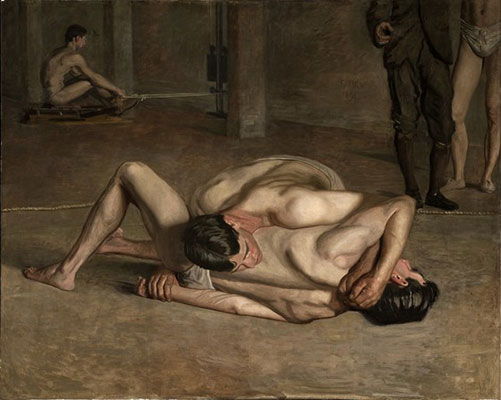
Wrestlers
The focus of Thomas Eakins' painting Wrestlers features two young males locked in a wrestling hold. The figure on top has wrapped his body around that of the male on the bottom whom he pulls toward him while pinning his right arm down with great force. In the background on the left, a wrestler uses a rowing machine, and on the right (shown from just above the waist down) is another athlete standing next to a suit-wearing coach, who points at the wrestling figures, in what is presumably an act of instruction.
Late in his career Eakins returned to one of his key themes: the sporting event. While earlier paintings focused on rowing scenes, later paintings included three boxing-themed works and this one wrestling scene, which is also the last genre painting the artist created. Often using his art as a vehicle for the exploration of movement, Eakins shows the height of action between two figures, their bodies locked in motion. He stated, "To draw the human figure is necessary to know as much as possible about it, about its structure and its movements, its bones and muscles, how they are made, and how they act."
The painting also highlights the modern approach Eakins took in his works. Desiring to depict as realistic a scene as possible, the artist first had two athletes come to his studio where he watched and then photographed them wrestling so he could settle on the best pose, which he then staged as the final photograph he used as the basis for his painting. While Eakins never shied away from depictions of the nude figure, this work is arguably his most direct, confrontational look at the male form. It is also, importantly, the last painting he created depicting the male nude.
Oil on canvas - Collection of Los Angeles County Museum of Art, Los Angeles, California
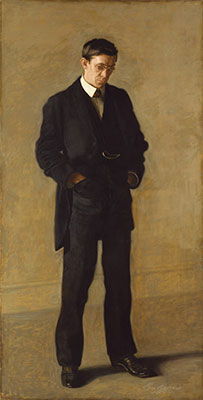
The Thinker (Portrait of Louis N. Kenton)
This painting features a full length image of a middle-aged man dressed in a black suit with white shirt, black shoes, and gold wire glasses. Aptly titled, the man stands with hands in his pockets looking as if deep in thought as he stares down at the floor. The somber tone of the work is reflected in the drab, nondescript, light brown background in which he is placed.
The subject of this work, Louis N. Kenton, was connected to the artist briefly during his short, troubled marriage to Eakins' wife's sister. Unlike many of his grand manner portraits, this work provides little reference to the subject's profession; however, the suit is typical of those who worked in Kenton's job as a clerk and bookkeeper. The minimalist nature of the painting actually makes it more modern than some of his other portraits as curator Kathleen A. Foster noted in describing this work as "a picture without narrative, setting, distinctive costume or properties, dramatic 'gesture or attitude,' yet richly signifying the character of modern life and art."
Eakins was well versed in study and reflection, and the composition of a figure deep in thought was a popular one for the artist. While often choosing subjects who were accomplished men and leaders in their fields, Kenton is the only figure Eakins painted in a single portrait who was firmly entrenched in the middle or working class. Initially criticized for its lack of beauty and sense of dull appearance, Eakins chose to embrace modern life through the depiction of an everyday man. Here he elevates an American middle-class male to the artistic importance of the European master portrait painting style once reserved for the richest, and most royal, of society.
Oil on canvas - Collection of The Metropolitan Museum of Art, New York, New York
Biography of Thomas Eakins
Childhood and Education
Thomas Eakins was the eldest of five children born to Benjamin and Caroline Eakins. Despite a supportive and secure childhood, Eakins experienced losses early in life, including the death of his younger brother.
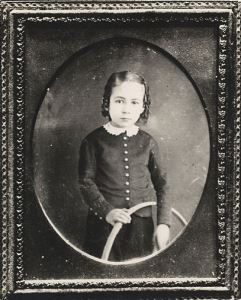
Raised in a family that valued education, Eakins graduated from Central High School in 1861 with a focus on art. He assisted his father, a writing teacher, as a calligrapher before enrolling in the prestigious Pennsylvania Academy of Fine Arts in 1862. Here Eakins took courses in drawing and focused on anatomy, a continuing interest throughout his career. To learn more he attended anatomy and dissection courses at Jefferson Medical College in 1864 and briefly considered a career as a surgeon. Upon turning twenty-one, in order to continue his studies uninterrupted, he paid the sum of twenty-four dollars to avoid being conscripted into the Union Army during the Civil War.
Early Training
As with many artists of the period, Eakins completed his art education and early training in Europe where he stayed from 1866 to 1870. Spending the majority of his time in Paris he attended the École des Beaux-Arts where he had the distinction of studying with the famed French artist Jean-Léon Gérôme who was known for his focus on the human figure.
What would become his only stay in Europe was a mixed experience. He greatly enjoyed his study of Diego Velázquez's paintings while in Spain and got his first experience of parental-free supervision, which included visiting a brothel with others in his class. Of this adventure he stated, "I saw more of new character and manner than I would ever have discovered by myself." However, he disliked the classical approach and the prudish attitudes of Victorian Europe regarding their objection to the depiction of the nude figure. As he wrote to his father, the female nude "is the most beautiful thing there is in the world except a naked man, but I never yet saw a study of one exhibited. It would be a godsend to see a fine man model painted in the studio with the bare walls, alongside of the smiling, smirking goddesses of waxy complexion."
Upon returning from Europe in 1870, rather than moving to New York City as so many artists of the time were doing, Eakins chose to stay in Philadelphia where he threw himself into his artistic pursuits, painting portraits and a series of rowing scenes. These early years as an artist were also filled with hardship. His mother was mentally ill and died in 1872. Then in 1873 while on a hunting trip, Eakins contracted malaria and was incapacitated for two months.
Quickly his portraiture work began to garner him attention, although it was not always well received as was the case with one of his most famous paintings The Gross Clinic (1875). He also received an important commission in 1877 to paint a portrait of President Rutherford B. Hayes, which has since been lost. The experience was not an easy one for Eakins, who found the President too restless to capture and likened the process to that of painting "a little animal."
His pursuits as a teacher ran concurrently with his painting career, and in 1876 Eakins became a professor's assistant at the Pennsylvania Academy and later an unpaid teacher at the Art Students' Union. It would not be until fall of 1879 that he would receive a full paid professor job at the Academy.
Mature Period
Photography would play an important role in Eakins' work, which began with the purchase of his first camera in the summer of 1880. Once Eakins fully embraced the art form, his preliminary sketches were largely replaced with numerous photographs of a scene or subject, which he would then use as the basis of his paintings. Eakins worked briefly with Eadweard Muybridge on his animal locomotion projects, and then in 1883, he began photographic studies of his own using a different technique. He later lectured on the subject in an 1885 talk on equine motion at the Pennsylvania Academy. His use of photography, however, proved controversial, as he was accused of tracing his paintings from projected photographs, a claim Eakins vehemently denied.
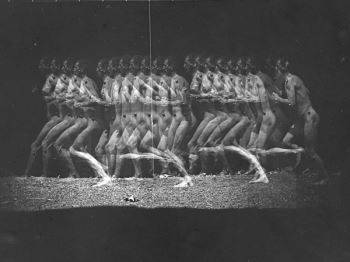
Eakins' interest in photography was as much about the artistic possibilities of the medium as it was about technological advancement. Throughout his career he maintained a strong interest in science, medicine, and other art forms. Choosing to surround himself with those in other disciplines, from the late 1880s onward, Eakins would meet with scientists and musicians. These weekly gatherings were affectionately referred to by Eakins' wife as "Tom's Sunday Club."
Throughout his life, family was important to Eakins. After the tragic death of his fiancée Kathrin Crowell of meningitis in 1879, Eakins married a former student Susan Macdowell in January of 1884. The couple had no children, and Macdowell dedicated herself to helping Eakins further his career. His family members were often the source of his portraits and appeared as subjects in his works. His father was especially supportive and allowed Eakins to convert the top floor of the family home into a studio. In a foreshadowing of scandal to come, Eakins' desire to work with the nude figure led to an arrangement between father and son that the activities in his studio were to be unquestioned. A written agreement between the two included the caveat that the artist had, "the right to bring to his studio his models, his pupils, his sitters, and whomsoever he will, and both Benjamin Eakins and Thomas Eakins recognizing the necessity and usage in a figure painter of professional secrecy, it is understood that the coming of persons to the studio is not to be the subject of comment or question by the family."
Eakins' desire to capture the true essence of the human form that began during his European trip as a young artist deepened as his work matured and would prove controversial on numerous occasions. In a mindset very much ahead of his time, Eakins believed if female students were admitted to his classes then they, too, should study the naked form. The repressive nature of society at that time meant that few shared the same view. Male students drawing from nude females was tolerated, but it was not viewed as proper that women be allowed to see and draw a nude male. Eakins pushed the boundaries of what was acceptable within the drawing classes of the academy, removing the scarfs that usually covered the female models' faces, and in an act that proved to be too much in January 1886, he removed a loincloth of a male model in a room that included female students. Ordered not to do this again, he was then asked to resign, which he did on February 9, 1886. Eakins passionately defended his actions, stating, "The thing is a nightmare ... It seems to me that no one should work in a life class who thinks it is wrong to undress if needful .. Was ever so much smoke for so little fire? I never in my life seduced a girl, nor tried to, but what else can people think of all this rage and insanity." Following the incident, thirty-eight of his students left the Pennsylvania Academy, and in an effort to provide a place where they could still be instructed by Eakins, they established the Art Students' League of Philadelphia.
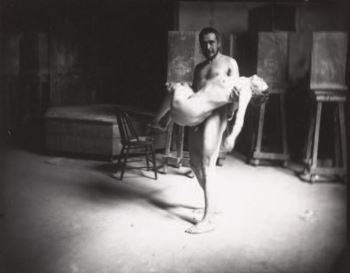
The controversy did not not end with Eakins' resignation from the Academy. His sister's husband led a charge to expel him from the Philadelphia Sketch Club on an undefined charge of "conduct unworthy of gentleman and discreditable to the organization." He was officially censured and asked to resign from his honorary membership, which Eakins refused, but the attempt caused a rift in his family. Eakins' father threw his daughter and her husband out of the family house, and Eakins and his sister never reconciled.
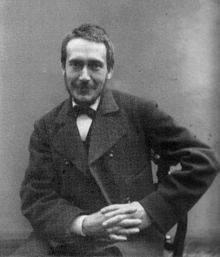
The effects of these scandals took their toll on Eakins, who suffering from depression, traveled in the summer of 1887 to a ranch in the Dakota Territory. The trip proved restorative, and he took many photographs and created paintings depicting cowboys and ranch life. Writing to his wife of his adventures, Eakins described his travels, "I think you would laugh to see me devour a big hunk of meat lifted out of the big fat pot it was fried in." He even bought a horse he named Billy and brought it back to Philadelphia to use as a model in future works. In fact, he also had a pet monkey named Bobby that was known to wreak havoc on his studio visitors.
Later Period
The last decades of Eakins' career were no quieter than those before. He received important commissions, including one to create a portrait of Dr. David Hayes Agnew, which led to the painting of his iconic work The Agnew Clinic (1889), another to collaborate on statues of Ulysses S. Grant and Abraham Lincoln, and the opportunity to create relief panels on the Trenton Battle Monument in New Jersey celebrating the Revolutionary War. While never known for his religious beliefs, his later years included portraits of many clergy members whom he befriended during Sunday afternoon visits to the nearby Saint Charles Borromeo Seminary.
Tragic and bizarre events continued to plague Eakins despite his flourishing career. In 1888 a former student, Lilian Hammitt, whose portrait Eakins was painting, developed a delusion that the artist was going to leave his wife and marry her. Eakins immediately stopped the portrait sessions, but she was found later by the police wandering the streets in a bathing suit and was institutionalized. Later in 1896, Eakins' beloved niece Eleanor, who had lived in the family home and taken painting lessons from Eakins, was institutionalized for mental illness, and in 1897, she committed suicide by shooting herself after informing her parents that her uncle had abused her in some undescribed way. This incident caused a firm break with yet another sister and her family.
In an ironic turn of fate in 1904 he was awarded a medal for a portrait by the Pennsylvania Academy who had demanded his resignation years before. Considering the circumstances under which he left the institution, it is not surprising that he was hostile over the award and upon receiving it stated, "I think you've got a heap of impudence to give me a medal." Shortly after he and friend Samuel Murray rode on bicycles to the United States Mint and turned in the medal for the sum of seventy-three dollars.
The last years of Eakins' life found him suffering from health issues, and his artistic output decreased. After 1908, his wife helped him to finish his last works. The artist died at the age of 71, likely of heart failure. Having felt that for the large part his art was not fully appreciated, Eakins once famously stated, "My honors are misunderstanding, persecution and neglect, enhanced because unsought." One can only speculate as to how he would have felt if he knew that his beloved Philadelphians would fight to keep his iconic Gross Clinic (1875) in the city when the Jefferson Medical College attempted to sell the painting almost a century later. The outrage was such that the city and private donors rallied to help raise the significant funds to keep the work, enabling it to ultimately be purchased jointly by the Philadelphia Museum of Art and the Pennsylvania Academy of the Fine Arts.
The Legacy of Thomas Eakins
Constantly at odds with the art establishment Eakins may well have failed to imagine the great mark he would leave on the art world. His style of modern realism, depicting themes of American life with brutal honesty, laid the foundation for the work of the next generation of artists such as Robert Henri, Edward Hopper, Dorothea Lange, Reginald Marsh, and Walker Evans. Contemporary artists have also drawn inspiration from Eakins as can be seen in the subjects of the portraits of British artist Lucian Freud.
Influences and Connections

-
![William Merritt Chase]() William Merritt Chase
William Merritt Chase -
![Jean-Léon Gérôme]() Jean-Léon Gérôme
Jean-Léon Gérôme -
![Eadweard Muybridge]() Eadweard Muybridge
Eadweard Muybridge - Christian Schussele
- Earl Shinn
![Walt Whitman]() Walt Whitman
Walt Whitman- Mariana Griswold van Rensselaer
-
![Modern Photography]() Modern Photography
Modern Photography -
![Realism]() Realism
Realism - History painting
![Walt Whitman]() Walt Whitman
Walt Whitman- Fairman Rogers
- Mariana Griswold van Rensselaer
Useful Resources on Thomas Eakins
- The Revenge of Thomas EakinsOur Pickby Sidney D. Kirkpatrick
- Thomas Eakins: His Life and Artby William Innes Homer
 Ask The Art Story AI
Ask The Art Story AI